With the recent rise in gardening thanks to the pandemic, perennial plants are finally getting some love and attention. I’ve personally seen my friends embarking on the journey of starting gardens to “grow their own food.” They are realizing some of their favorite foods are actually perennial plants and can provide sustainable food products.
What is a perennial plant?
This is any plant that grows year after year. Some plants are biennials which means they have a 2-year plant cycle. And some plants like potatoes are perennials grown as annuals for the sake of the harvest. For the sake of this post today we’re talking about just edible varieties and not ornamental varieties.
What are the benefits of growing perennial plants?
They’re extremely low maintenance once they are established. They often need less water and trimming once a year or so at most. Perennial plants offer biodiversity to a permaculture situation. They also make excellent companion plants. For example, blueberries and radishes are great together. Beyond that, they build soil because the soil isn’t turned up and exposed to air and sunlight every season like for annual plants.
So, what’s my list of the 20 tastiest edible perennials?
1) Raspberries:
These grow wild all over the United States if you know where to look but they make excellent hedges to your garden or yard.
2) Asparagus:
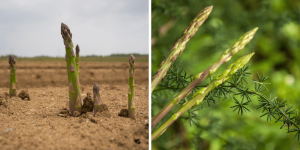
It takes about 2 years after planting to get to the point of harvesting. I harvested asparagus fresh once from a friend’s patch about 5 years ago and believe me there is nothing quite as tasty as freshly cut asparagus. It oozes water from the cut ends like a faucet. That end is usually long dried and wrinkled by the time it makes it into stores. They also pair well with tomatoes for companion plants.
3) Rhubarb:
Known for being one of the first foods to be available in the spring, rhubarb is grown for its bright pink tart stalks. Just grow in an area with full sun and water regularly. If you live in a hot area plant where it’ll be protected from the hot afternoon sun. Don’t overwater and be sure to make plenty of strawberry rhubarb pie!
4) Kale:
In my experience kale is one of those seeds you can plant in the spring and forget about until it’s time to harvest. It’s best to keep in partial shade if you’re planting in the summer. Keep soil consistently moist and you’ll have an amazing super regular harvest.
5) Garlic:
Start garlic in autumn by planting 4-6 inches apart covered with 1-2 inches of fine soil. Growth will either happen in late fall or early spring depending on your climate.
6) Radicchio:
It is bright purple, loves cold weather, and will supply you with salad greens for a long time when grown properly. Like most greens, grow Radicchio in partial shade or cold climates for best results.
7) Horseradish:
I grew this in my farm in Cleveland. A friend brought some live roots and I broke them up and buried them in several places. Once you plant it and it’s established, it grows forever without maintenance. Roots can be found underground year-round although in winter the ground may not be easy to access because of ice.
8) Globe Artichokes:
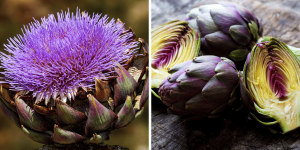
These are in the same families as sunflowers. They’re known as short-lived perennials in warm climates. They are grown for the edible flower buds. In the center is the flavorful artichoke heart best steamed and served with salt and butter. They do best in Mediterranian climates and prefer full sun and well-drained soil. It takes them 2 years to flower so if you’re growing in cold climates, grow in a container so you can move indoors during the winter. You can buy year old plants or just buy seeds and start those.
9) Bay Laurel:
Technically a tree, its dark green leaves are used as a kitchen seasoning. I use them for broths especially myself. Another Mediterranean plant, it prefers warmer weather. If you live in a colder climate, wrap the container in bubble wrap during the winter until spring if you can’t bring it indoors. These are often grown and sculpted as ornamental plants.
10) Watercress:
This is considered a weed in many places but it makes an excellent salad green. It has a slightly peppery flavor that complements regular salad greens perfectly. It’s usually found growing in running water and flooded areas. This can be recreated at home with water features. Watercress can also be grown in constantly wet soil in full sun. You can also grow it in buckets.
11) Blueberries:
They are tolerant of shade but they do better in a sunny but sheltered spot. It’s best to do whatever you can to protect them from winds. Also, keep them away from trees because the trees take the majority of the moisture. It prefers soil that holds moisture but drains well, so not very clay-rich. They also prefer acidic soil. They need one to 2 inches of water per week to grow happily along with training.
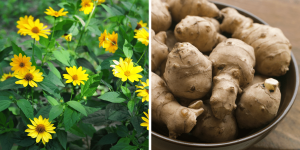
15) Jerusalem Artichoke:
I had these out of a friend’s garden a few years ago in Ohio. Jerusalem Artichokes are super pretty and take no maintenance, but provide plenty of these little tubers. They have big daisy-like flowers and below ground, they grow tubers. Artichokes do better in colder climates so in warmer climates, expect smaller harvests. They work great as a windbreak so perhaps grow these side by side with those blueberries!
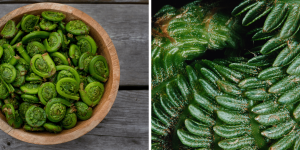
16) Fiddleheads (Ostrich Ferns):
Fiddleheads are a foragers delight. But you can also get some Ostrich fern plants yourself and grow a harvest right in your backyard. Fiddleheads are just the coiled new leaves of the Ostrich Fern before it opens. Fried in butter with salt they’re reminiscent of asparagus. Avoid eating raw because of shikimic acid. They prefer 2-3 feet of space between plants and light or partial shade. It can tolerate full sun if the soil stays moist.
17) Wild Leeks:
This is another easy to find perennial where I come from. Look for the green growth in early spring. However, you can grow these from seeds. Plant bulbs in February or March if using starts instead of seeds. They naturally grow in shaded areas in rich well-draining soil.
18) Scarlet Runner Beans:
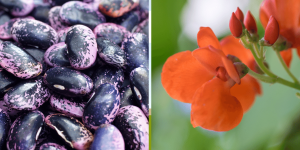
Nearly 10 years ago my best friend’s Mom gave me some scarlet runner beans. I was excited from the beginning because the beans are huge black and purple speckled beauties. She told me the flowers were spectacular and she was right. These do best with a trellis or in the “3 sisters” formation. All parts of the plant are edible including the bright red flowers. Beans are incredible either as green beans or fully matured and dried.
19) Rosemary:
Rosemary can be grown from seed but is also easy to propagate through cutting. Grows best in full sun. Water once every 1-2 weeks or risk overwatering. There’s nothing like fresh rosemary in a soup and it’s also nice to have on hand if you like to smudge.
20) Mint:
Mint is incredible and easy to grow but if you aren’t careful it will eat your entire garden. Literally. It’s highly invasive and spreads as groundcover which is great if you love mojitos or mint tea. I grow it in containers. You can make new plants by burying branches of existing plants and watering. Within a week there should be roots and you can separate from the main plant and plant separately.
There are many more than this! This is a list of the perennials I have the most experience with. These are excellent for lazy gardeners who just want to plant things and forget about them until its time to eat.
What are your favorite perennial vegetables? Tell us in the comments!
Read more about Biointesive Gardening



